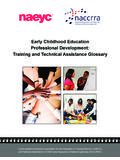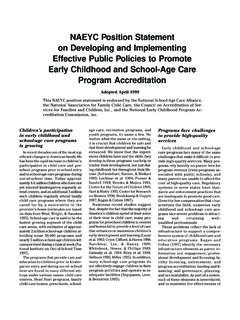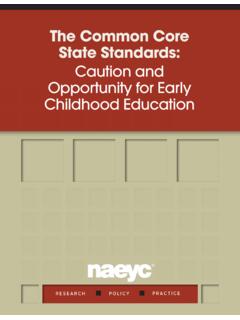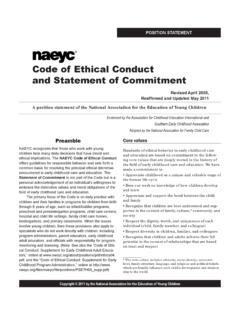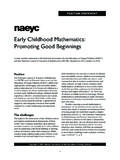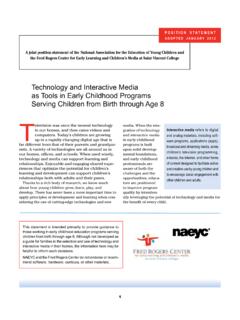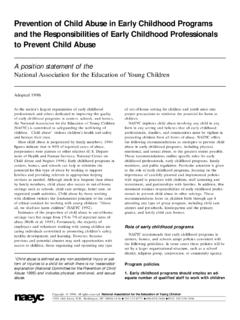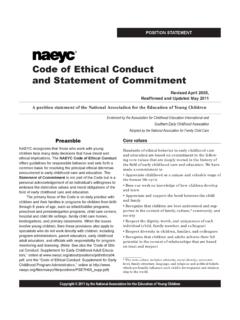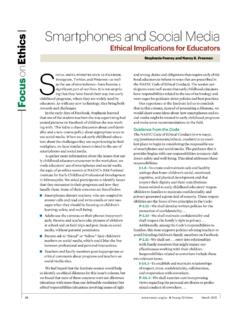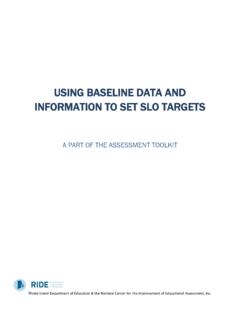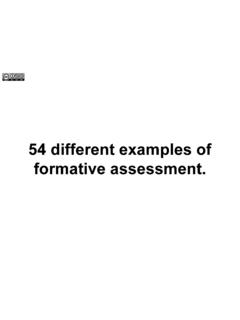Transcription of The Benefits of Developing a Professional Portfolio - NAEYC
1 92 Reprinted from Young Children January 2010 Degree in hand, thousands of early childhood students leave college each year with dreams of making a differ-ence in the lives of young children. Countless veteran professionals inter-view for new or different positions or share their beliefs with colleagues and families. Even climbing the career ladder within the same program may require an interview for each new position. Yet how many times have we pre-pared for interviews only to draw a blank when the time comes to share our knowledge and understanding?
2 What can we do to prepare to articu-late our thoughts, ideas, and beliefs when we apply for an early childhood position? How might we organize documents reflecting our philosophy and goals, Professional growth, and experiences? My years of work with preservice early childhood teachers, new pro-fessionals, and organizations that recruit beginning professionals have helped me identify key activities and documents to be incorporated into a Professional Portfolio . A well-organized Portfolio can help newer practitio-ners effectively express their beliefs and experiences during the interview process as well as document their ongoing Professional growth.
3 Walking into an interview or other meeting with a Portfolio in hand speaks vol-umes about the Professional that you are, and a Portfolio often impresses the interviewer or peer. It can be a determining factor in whether a pro-gram considers you a good a Portfolio is and is not Before discussing what a Portfolio is, let s determine what it is not. A Professional Portfolio is not a photo album. There is a place in the Portfolio for photos, but they should directly relate to a lesson plan, letter to families, or other docu-ment on display.
4 Is not a scrapbook. We will discuss the creative display of materials, but your Portfolio should highlight your skills, not distract from them. is not a package to hand to the inter-viewer to be read from front to , what is a Portfolio , if the employer is not supposed to look through it? What is the point? The kind of Portfolio we are talking about documents your beliefs, pro-fessional development, experience, involvement in the field, and class-room/program use of best practices. It is a visual tool to help you verbally answer questions.
5 You can use the contents to demonstrate or illustrate a key point. Many interviewers are required to ask applicants identical questions, and a Portfolio lets you stand out from other candidates. The key to success lies in how you organize and use the Portfolio . Think about what you would like to talk about at an interview, antici-pate possible questions that may be asked, and then include items in your Portfolio that illustrate these points. Referring to the items provides visual cues for verbally sharing your philoso-phy, experiences, and pedagogy.
6 With Cheryl Priest, EdD, is an assistant professor of human development and family studies and the faculty director of the Child Development and Learning Laboratory at Central Michigan University, in Mount Pleasant. She has spent the last 10 years supporting graduating seniors in early childhood education as they complete their student teaching, learn to represent their knowledge in creative ways, and embark on the search for excit-ing career opportunities. This article is available in an online archive at Benefits of Developing aProfessional PortfolioCheryl PriestWhat curriculum styles are you most familiar with, and which do you follow most closely?
7 What would a daily schedule look like in your classroom?What tools would you use to communicate information to families?Reprinted from Young Children January 201093 Landsmanthoughtful preparation, your Portfolio will not only provide a distinct inter-viewing advantage but also will help you grow Benefits of a Portfolio Imagine that you apply for a teach-ing position at a preschool. When you arrive for a scheduled interview, one of the first questions the interviewer asks is, We are very interested in the creative development of children.
8 Could you please describe a creative experience you planned and explain what you like about it? Without a Portfolio as a guide, you might rack your brain trying to recall a suitable art activity, then respond, Hmmm. Well .. I remember one time when I laid contact paper out on the table and peeled off the back so the sticky side was up. The children then used things like feath-ers and sequins to decorate the contact paper. I guess I like this activity because it is open-ended and doesn t focus on a spe-cific end product.
9 Instead, Portfolio in hand, you turn to a lesson plan on creative development and say, I have a perfect example here in my Portfolio . [Pointing to the title and objective of the lesson plan] I planned a sticky collage activity for children to work on in small groups. The objective was to have children work together while exploring creative materials. After asking what materials might stick to the contact paper, I encouraged the children to work together to select and place materials. [Pointing to the extension section of the lesson plan] I also prepared open-ended questions I could use to stimu-late explorations, such as, What do you notice about the way these mate-rials look together?
10 Or How might we make a flower on this collage ? For children who needed more creative challenges, I asked questions such as, What makes that a good idea? I really liked this experience because children could take the lead in choosing which materials to use and how they wanted to use them, based on their previous experiences and knowledge. It required children to communicate with each other and to work together throughout the pro-cess. See, in these pictures, it s clear how involved the children became the happy and focused looks on their faces show how successful the activity was.
